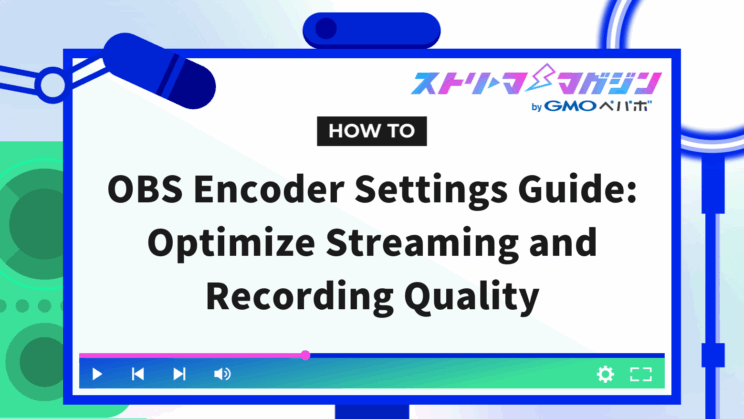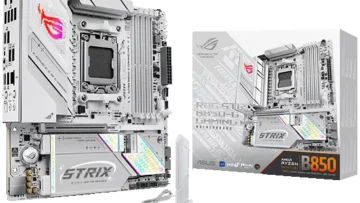OBS Encoder Settings Guide: Optimize Streaming and Recording Quality

Index
- The Importance of Encoder Settings in OBS
- Recommended Encoder Settings in OBS for Different Use Cases
- Encoder Settings That Affect Video and Audio Quality in OBS
- 5 Steps to Apply Recommended Encoder Settings in OBS
- How to Use the OBS Auto-configuration Wizard for Encoder Settings
- OBS Encoder Settings for Different Streaming Platforms
- Adjusting OBS Encoder Settings When Quality is Poor or Unstable
- Key Encoder Settings for Using OBS on Low-Spec PCs
In OBS Studio, encoder settings are essential for high-quality streaming and recording. However, there are many encoder settings to consider, which may leave some people unsure of how to configure them properly.
In this article, we will explain how to configure encoder settings in OBS for high-quality streaming and recording.
The Importance of Encoder Settings in OBS
The quality of streaming and recording in OBS is largely determined by the encoder settings. Here, we will explain the role of the encoder in OBS and the importance of its configuration.
What is an Encoder?
An encoder is a technology that converts video and audio data into a digital format, effectively compressing it. Raw video and audio data are often too large to process directly, necessitating compression via an encoder into a format that can be efficiently transmitted over the internet.
In OBS, you can choose between a hardware encoder (using the GPU) and a software encoder (using the CPU), and it’s important to select one based on your PC environment and specific requirements.
The Importance of Encoder Configuration
Properly configuring the encoder allows you to deliver high-quality content to viewers. Settings such as bitrate and resolution directly affect the smoothness and clarity of video. Audio encoder settings are also crucial for achieving clear audio quality.
By optimizing these settings, viewer satisfaction increases, which can lead to streaming success.
Recommended Encoder Settings in OBS for Different Use Cases
There is no one-size-fits-all answer for OBS encoder settings. The optimal configuration varies depending on the intended use. Here, we will discuss recommended settings for streaming and recording with OBS.
Recommended Encoder Settings for Streaming
Streaming entails delivering video content to viewers via the internet, requiring settings that take into account internet conditions. Below are recommended settings for streaming as a reference.
| Setting | Recommended Configuration |
|---|---|
| Audio Encoder | CoreAudio AAC ※Available via iTunes download |
| Video Encoder | NVIDIA NVENC H.264 |
| Rate Control | CBR |
| Bitrate | 6,000kbps or higher ※Up to the site limit |
| Keyframe Interval | 2s |
| Preset | P5: Slow (High Quality) |
| Profile | High |
| Multipass Mode | 1 pass |
| Audio Bitrate | 128kbps |
| Output Resolution | 1920×1080 (1080p) |
| Frame Rate | 60FPS |
Recommended Encoder Settings for Recording
Unlike streaming, recording does not require consideration of internet conditions. The table below provides recommended settings for high-quality recording.
| Setting | Recommended Configuration |
|---|---|
| Audio Encoder | CoreAudio AAC ※Available via iTunes download |
| Video Encoder | NVIDIA NVENC H.264 |
| Rate Control | CQP |
| Bitrate | 6,000kbps or higher |
| Keyframe Interval | 0s |
| Preset | P5: Slow (High Quality) |
| Profile | High |
| Multipass Mode | 2 passes (1/4 resolution) |
| Audio Bitrate | 192kbps |
| Output Resolution | 1920×1080 (1080p) |
| Frame Rate | 60FPS |
Encoder Settings That Affect Video and Audio Quality in OBS
As outlined in the recommended settings above, various encoder settings in OBS can influence performance. In this section, we’ll detail each setting’s specifics.
Audio Encoder
The audio encoder compresses audio data and converts it to a suitable format for streaming or recording. Choosing the right encoder can improve audio quality at the same bitrate, delivering clearer sound to your audience.
Examples of audio encoders available in OBS include the following:
- FFmpeg AAC
- CoreAudio AAC ※Available for free via iTunes download
While FFmpeg AAC is sufficient, CoreAudio AAC is recommended for higher audio quality.
Video Encoder
The video encoder compresses video data and converts it to a suitable format for streaming or recording. Choosing the right encoder can enhance video quality at the same bitrate, ensuring high-quality video delivery to viewers.
OBS supports both software encoders (using the CPU) and hardware encoders (using the GPU), with the following video encoders available:
| Encoder | Features |
|---|---|
| x264 | Uses CPU for low-latency and high efficiency |
| NVIDIA NVENC H.264 | Uses NVIDIA GPU for low latency and high efficiency |
| NVIDIA NVENC HEVC | Uses NVIDIA GPU for 4K or high resolution |
| NVIDIA NVENC AV1 | Uses NVIDIA GPU for latest AV1 support and high compression efficiency |
| AOM AV1 | Open-source with high efficiency |
| SVT-AV1 | Offers high compression efficiency and quality |
| QuickSync H.264 | Uses Intel GPU for fast processing |
| QuickSync HEVC | Uses Intel GPU for high resolution |
| AMD HW H.264 | Uses AMD GPU for high efficiency |
| Apple VT H264 Hardware Encoder | Mac-oriented, providing high quality and efficiency |
Note that the encoders available for selection may vary based on your PC environment, with some setups only offering x264. While NVIDIA NVENC is recommended, if it’s unavailable, use x264 for software encoding.
Rate Control
Rate control refers to how the encoder manages bitrate (data volume) when compressing video data. Proper selection optimizes the balance between video/recording quality and file size, allowing high-quality video delivery to viewers.
The following rate control options are available in OBS:
- CQP: Maintains constant image quality
- CRF: Adjusts bitrate while maintaining a consistent quality
- CBR: Encodes at a fixed bitrate
- VBR: Dynamically adjusts bitrate based on scene complexity
- ABR: Encodes based on average bitrate
These options vary by video encoder. For streaming, CBR is recommended, while CQP or CRF is suitable for recording.
Bitrate
Bitrate indicates the amount of data processed or transmitted in one second, directly impacting the quality of video and audio. Although a higher bitrate provides higher quality, it also increases file size.
For high-quality streaming/recording in OBS, a bitrate of 6000kbps or higher is recommended for Full HD (1920×1080).
If rate control is set to CQP or CRF, instead of specifying the bitrate directly, the quality level is adjusted.
For CQP or CRF settings, lower numbers indicate higher quality but larger file sizes. A setting of 20 is generally a good baseline.
For more information on bitrate for streaming and recording with OBS, refer to the linked article.
[OBS Bitrate Guidelines] Clear Explanation for Streaming & Recording Settings
Keyframe Interval
The keyframe interval setting indicates how often full frames (keyframes) are inserted during video encoding. Keyframes are reference frames for subsequent frames, affecting video compression efficiency and quality.
Shortening the keyframe interval improves quality but increases data volume. Conversely, lengthening it reduces data volume but might lower quality, requiring careful consideration.
For recording, an interval of 0s is recommended, and 2s for streaming.
CPU Usage Preset
The CPU usage preset determines the balance between processing speed and quality during video compression. Faster settings reduce CPU load but compromise compression efficiency and quality, whereas quality-prioritized settings enhance quality but increase CPU load.
With NVIDIA NVENC in OBS, the following preset options are available:
- P1: Fastest (Lowest Quality)
- P2: Faster (Lower Quality)
- P3: Fast (Low Quality)
- P4: Medium (Medium Quality)
- P5: Slow (High Quality)
- P6: Slower (Higher Quality)
- P7: Slowest (Highest Quality)
The recommended settings are P4: Medium (Medium Quality) or P5: Slow (High Quality), but select a preset based on your streaming environment and PC performance.
Profile
The profile determines compression efficiency and compatibility during encoding. In OBS, the following settings are available:
- Baseline
- Main
- High
High provides the highest compression efficiency and quality, making it a favorable choice for high-quality streaming/recording in OBS.
Multipass Mode
Multipass mode is an encoding technique that analyzes and compresses video data multiple times.
With a choice between 1 pass and 2 passes, 1 pass is faster but potentially results in unstable quality due to predictive encoding. In contrast, 2 passes analyze data beforehand and allocate bitrate optimally, leading to high-quality results even for dynamic footage, though it extends encoding time.
For streaming with CBR rate control, 1 pass is recommended, while 2 passes are suitable for recording with CQP/CRF.
If you want to learn more about Multi-Pass Mode, check out the article below.
The Complete OBS Multi-Pass Mode Manual! Recommended Settings for Different Uses
Audio Bitrate
Audio bitrate is an indicator of the amount of audio data processed or transmitted per second, directly affecting sound quality. While higher bitrates provide better quality, they also increase file size.
Available audio bitrate options in OBS include:
- 32
- 40
- 48
- 56
- 64
- 72
- 80
- 96
- 112
- 128
- 144
- 160
- 192
- 224
- 256
- 288
- 320
Generally, a bitrate of 192kbps or higher is recommended for broadcasts involving music or high-quality sound.
Output Resolution
Output resolution refers to the vertical and horizontal dimensions of the video produced during streaming or recording. While higher resolution offers clearer images, it increases data volume, impacting viewer bandwidth and PC processing capabilities.
Available output resolution choices in OBS include the following:
- 1920×1080
- 1536×864
- 1440×810
- 1280×720
- 1152×648
- 1096×616
- 960×540
- 852×480
- 768×432
- 696×392
Full HD (1920×1080) is generally recommended for high-quality viewing. However, due to the larger data volume, reduce the resolution to 1280×720 if you encounter stuttering or other issues, and adjust your output resolution to suit the viewing environment and platform settings.
Frame Rate
Frame rate (fps) indicates the number of images displayed per second, directly influencing video smoothness. While a higher frame rate is effective for scenes with lots of motion, it increases data volume and places greater load on PCs and internet connections.
The frame rate settings available in OBS include:
- 10
- 20
- 24 NTSC
- 25 PAL
- 29.97
- 30
- 48
- 50 PAL
- 59.94
- 60
For high-quality game streaming and recording, 60fps is generally recommended.
5 Steps to Apply Recommended Encoder Settings in OBS
This section outlines the steps to apply the recommended settings discussed earlier.
STEP 1|Change Output Mode
To fine-tune encoder settings, change the output mode to “Advanced” with the following steps.
1. Launch OBS and click “Settings”.
2. Click “Output”.
3. In Output Mode, select “Advanced”.
These steps will allow you to configure the encoder settings in detail.
STEP 2|Configure “Streaming”
Apply the recommended settings for “Streaming” using the following steps.
1. Click “Streaming” to open.
2. Configure “Streaming Settings”.
Apply the following recommended settings.
- Audio Encoder: CoreAudio AAC
- Video Encoder: NVIDIA NVENC H.264
3. Configure “Encoder Settings”.
Apply the following recommended settings.
- Rate Control: CBR
- Bitrate: 6000kbps or higher
- Keyframe Interval: 2s
- Preset: P5: Slow (High Quality)
- Profile: High
- Multipass Mode: 1 pass
With these steps, streaming settings are complete.
STEP 3|Configure “Recording”
Apply the recommended settings for “Recording” using the following steps.
1. Click “Recording” to open.
2. Configure “Recording Settings”.
Apply the following recommended settings.
- Video Encoder: NVIDIA NVENC H.264
- Audio Encoder: CoreAudio AAC
For the recording format, MPEG-4 is recommended due to its compatibility.
3. Configure “Encoder Settings”.
Apply the following recommended settings.
- Rate Control: CQP
- CQP Level: 20
- Keyframe Interval: 0s
- Preset: P5: Slow (High Quality)
- Profile: High
- Multipass Mode: 2 passes (1/4 resolution)
With these steps, recording settings are complete.
STEP 4|Configure “Audio”
Apply the recommended settings for “Audio” using the following steps.
1. Click “Audio” to open.
2. Set the Bitrate.
Normally select 192kbps or higher, and choose 128kbps for streaming according to the streaming site requirements.
Audio settings are complete with these steps.
STEP 5|Configure “Video”
Apply the recommended settings for “Video” using the following steps.
1. Click “Video” to open.
2. Configure “General”.
Apply the following recommended settings.
- Output (Scaled) Resolution: 1920×1080
- FPS: 60
Video settings are complete with these steps.
How to Use the OBS Auto-configuration Wizard for Encoder Settings
OBS comes with an auto-configuration wizard to automatically set encoder settings according to your PC environment. However, keep in mind that the wizard’s settings may not always be optimal, so use them as a general guide.
The following steps describe how to use the auto-configuration wizard for encoder settings.
1. Launch OBS and click “Tools > Auto-Configuration Wizard”.
2. Select your goal and click “Next”.
3. Choose resolution and FPS, then tap “Next”.
4. For streaming, select a streaming site and connect an account.
5. Recommended settings will be displayed; if you wish to apply them, click “Apply Settings”.
With these steps, the auto-configuration wizard for encoder settings in OBS is complete.
OBS Encoder Settings for Different Streaming Platforms
When streaming with OBS, some opt for high bitrates to achieve good quality. However, streaming sites have bitrate limits, and exceeding these limits will not deliver a smooth experience for viewers.
Use the maximum bitrate limits summarized in the table below as a reference to set your bitrate correctly.
| Streaming Site | Bitrate Limit |
|---|---|
| TwitCasting | 60,000kbps |
| YouTube Live | 51,000kbps |
| Niconico Live | 6,000kbps |
| Mildom | 6,000kbps |
| Twitch | 6,000kbps |
| OPENREC.tv | 5,000kbps |
| Mirrativ | 1,000kbps |
Adjusting OBS Encoder Settings When Quality is Poor or Unstable
While the recommended settings discussed earlier aim for best practices, they may not suit every PC. If you experience reduced or unstable quality, consider adjusting the settings below.
| Adjustment Item | Setting Details |
|---|---|
| Output Resolution | Change 1920×1080 to 1280×720 |
| FPS | Change 60 to 30 |
| Preset | Change P5: Slow (High Quality) to P4: Medium (Medium Quality) or P3: Fast (Low Quality) |
Find the optimal settings for your PC environment.
Key Encoder Settings for Using OBS on Low-Spec PCs
Even on low-spec PCs, high-quality streaming and recording are possible with the right configuration and encoder settings. Below is a table of points to consider when using a lower-performance PC for OBS.
| Key Point | Details |
|---|---|
| Free Up Memory | Close unnecessary processes in Task Manager to allocate memory to OBS |
| Run as Administrator | Run as administrator to prioritize OBS memory usage |
| Lower Resolution and FPS | Change 1920×1080 and 60fps to 1280×720 and 30fps |
Prioritizing memory allocation on low-spec PCs and identifying settings that avoid excessive load are crucial.
In this guide, we’ve explained OBS encoder settings to enhance streaming and recording quality. Higher-quality streams bring a more comfortable viewing experience to audiences. Refer to the summarized recommended settings below for achieving high-quality streaming and recording.
| Setting Item | Recommended Settings for Streaming | Recommended Settings for Recording |
|---|---|---|
| Audio Encoder | CoreAudio AAC | CoreAudio AAC |
| Video Encoder | NVIDIA NVENC H.264 ※Use x264 if unavailable | NVIDIA NVENC H.264 ※Use x264 if unavailable |
| Rate Control | CBR | CQP ※Use CRF if using x264 |
| Bitrate | 6,000kbps or higher ※Up to the site limit | 6,000kbps or higher |
| Keyframe Interval | 2s | 0s |
| Preset | P5: Slow (High Quality) | P5: Slow (High Quality) |
| Profile | High | High |
| Multipass Mode | 1 pass ※No setting if using x264 | 2 passes (1/4 resolution) ※No setting if using x264 |
| Audio Bitrate | 128kbps | 192kbps |
| Output Resolution | 1920×1080 (1080p) | 1920×1080 (1080p) |
| Frame Rate | 60FPS | 60FPS |








